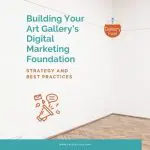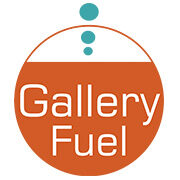Your gallery artist roster and their artworks are the stars of your website. I know you want to present them online in the best possible manner, so they get the attention they deserve and inspire art sales.
Creating a well-structured gallery webpage is crucial for showcasing an artist’s work while ensuring a seamless buying experience for visitors. The design should be clean and intuitive, allowing the artwork to remain the focal point. High-quality images with zoom functionality help potential buyers appreciate the details, and a mobile-friendly layout ensures accessibility across devices.
Each artist should have a dedicated showcase page featuring their biography, portfolio, and artist statement. Searchable metadata, including the artist’s name, medium, and style, enhances discoverability. Easy navigation is also essential—categorizing artworks into sections such as paintings, sculptures, and digital art makes browsing effortless. Filters for sorting by price, size, or style further streamline the user experience.
Engagement and accessibility should also be priorities. A clear contact form encourages inquiries, while newsletter subscriptions provide updates on new collections and exhibitions.
 Below, I have outlined simple ways to make your gallery’s artist roster, portfolio, and biography pages more valuable to prospective art buyers. When art collectors shop online, they expect comprehensive information and an exceptional browsing experience.
Below, I have outlined simple ways to make your gallery’s artist roster, portfolio, and biography pages more valuable to prospective art buyers. When art collectors shop online, they expect comprehensive information and an exceptional browsing experience.
Gallery Artist Roster Page
- The most effective design for an artist roster page is a grid style with artwork images and names. Roster pages that comprise only a list of names can be frustrating for the viewer who is browsing. All that clicking back and forth makes it difficult for them to find art that appeals. Images help the discovery process.
- If you represent many artists working in a variety of mediums, organize your artist inventory page by medium to enhance the viewing experience. This layout helps alleviate feelings of being overwhelmed by too many choices.
- You might also feature artists on this page who were part of your past, current, and upcoming exhibitions.
Artist Portfolio Pages
- Adding text, along with images and necessary information (title, medium, size, and price), about the works in the portfolio is essential. Search engines rely upon the on-page text with keywords to index correctly in search results. For potential buyers, the descriptive text provides a deeper understanding of the work and enhances the ability to connect emotionally or intellectually. This content strategy makes the website experience more engaging and helps art collectors connect with a specific piece in the portfolio. That’s what it’s all about…. Right?
- Most gallery artist portfolio pages use only the artist’s name as the headline. The headline is valuable real estate for both viewers and search engines. It is an excellent opportunity to communicate something important. After all, viewers probably got the artist’s name on the roster page. A headline may spark curiosity and persuade the reader to explore further. Headline ideas might include something about what the artist is best known for or an unusual technique.
- Many art gallery websites still display small images of artwork, leaving a lot of white space on the page. This design element is a waste of visual real estate. Present artwork images that allow the viewer to see it as large as possible and even zoom in on the detail.
- Post multiple images of a piece, including the work framed and unframed, detail shots, and a wall view with a piece of furniture next to it to give a better idea of scale.
- Include an inquiry link on every artist’s portfolio page or for every artwork, depending on the program you use. Make it super easy to contact the gallery for more information.
- Provide relevant information for making a buying decision, such as price, edition, framing options, condition reports, provenance, and authenticity information.
- Other information vital to considering a purchase online includes gallery policies, such as return policies, shipping, financing, and approval policies, among others. Don’t require potential buyers to search for this information. Place links to where they can find this information elsewhere on your gallery’s website.
Artist Biography Pages
- Use storytelling on your artist bio pages to help collectors understand what drives an artist to create and why the gallery is passionate about supporting that artist. Make the story unexpectedly interesting. Standard CV information makes a dull bio page and is a missed opportunity for building SEO. An artist’s story aims to create a connection between the potential art buyer and what the artist is trying to accomplish with their work.
- Tell stories visually as well. Please include photos of the artist at work in their studio, past show pictures, and videos on the artist’s bio page. Doing so helps site visitors to have a more comprehensive understanding of the artist. If possible, include images of the artist’s work installed in client spaces. These visuals help buyers imagine how pieces might enhance their living space as well.
- Use headers and sub-headers to allow visitors to skim a page and quickly find information that most interests them. Also, remember that reading online is best with short paragraphs.
- Link back to other pages of your website. For example, any past blog posts or media write-ups. This keeps people on the site for longer and makes them more engaged.
To the Point
Your website, as a sales and marketing tool, should educate and entice viewers to take the next step by exploring additional information on the gallery website, learning more, contacting the gallery, or ultimately making a purchase. Not every artist can have a show in the gallery every year, but you can present them online in a more complete and informative way.
Web surfers demand easy navigation and expect to immediately find the information they want. A poor browsing experience or slow page loading can affect your website’s drop-off rate and search engine index results. Search engines favor websites with rich content that is continuously being refreshed. Don’t let your artists’ portfolio and bio page get stale.
Sometimes, artwork speaking for itself may not be enough to grab and hold a site visitor’s attention. Storytelling, both through text and visuals, can be very compelling when it comes to getting collectors to envision living with a particular piece.
Use these easy suggestions to make your art gallery’s website a marketing and sales powerhouse for your artists and a delightful experience for your site visitors.
You may also enjoy these related articles:
Top 5 SEO Considerations for Optimizing your Art Gallery Website
Easy Steps to Audit Your Art Gallery Website
Strategy and Best Practices: Building an Art Gallery Marketing Foundation


Leave a Reply